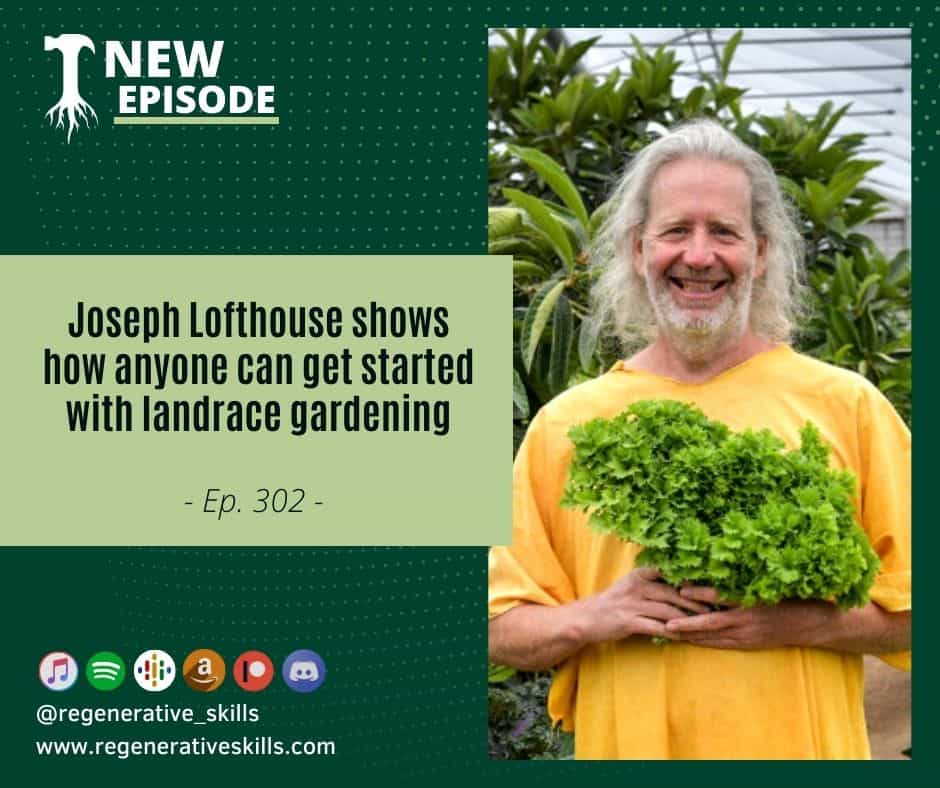
I’ve been looking forward to today’s session for a good couple months now.
Though it’s been years since I got excited about seed saving and heard the first little bits of the ideas around landrace gardening, I only recently got a window into its real potential. I honestly feel a bit embarrassed that I didn’t know more about landrace plant breeding until recently since it’s the reason we have pretty much all the domesticated and semi-domesticated varieties of food that you can find all over the world. It also turns out to be an incredibly approachable practice that throws out the traditional rule book of plant breeding with its meticulous adherence to detailed record keeping, isolation distances, and inbreeding.
But instead of hearing about it from me, let me introduce you to Joseph Lofthouse.
Joseph adopted the principles of landrace gardening in response to the harsh growing conditions in a high-altitude, short-season, desert garden. Instead of relying on expensive poisons, labor, and materials to coddle the plants, he instead encourages genetic diversity, cross-pollination, and survival of the fittest, allowing the plants to adapt themselves to the current and ever-changing ecosystem, thus simplifying gardening and seed saving. Joseph is the author of Landrace Gardening: Food Security Through Biodiversity and Promiscuous Pollination, and he was kind enough to send me a copy ahead of this interview.
I don’t always have the chance to read the books that get sent to me by publishers and authors in their entirety, but I have to admit I ate this one up and fully got through it cover to cover.
In our conversation today, Joseph and I start by uncovering his personal pathway as a farmer early on and the failures and frustrations with seeds available in the stores that led him to experiment with landrace growing.
Not only does Joseph face many challenges in the high desert environment up at more than 5000 ft of elevation in Utah, but he also practices what he calls “vacant lot farming,” which quite literally means he’s farming on abandoned plots of poor soil.
From there we get more technical by clarifying the difference between a heirloom variety, a hybrid, open pollination, and a landrace, and why it’s so important for us as growers to move away from the industrialization of seeds and plant breeding.
I also wanted to expand on the initial knowledge around the basic concepts of landrace gardening that we explored a couple weeks ago on this show in an interview with Julia Dakin who is a collaborator of Joseph’s. Together they created the “Going to Seed” network and free online course platform to promote landrace growing and seed sharing. In that interview we covered a lot of practical information and basics, and so I will recommend that you go back and listen to it in case we’ve skipped any essentials in this session.
So building on that previous interview we dug into some of Joseph’s personal experiences and stories from trialing hundreds of landrace projects on his farm and some of the truly unique findings and evolutions that he’s witnessed. He also offers essential insights into not only the tips and tricks that have led to his successful breeds, but also the mindset and expectations that have helped him remain open to unexpected outcomes and the patience required for growing and reproduction cycles.
Touching on a deep interest of mine within the broader topic, we also navigate the challenges and potential of landrace trees and perennial crops. Joseph has a close family connection to walnut breeding and shares insights into the legacy work that this practice is for him.
Over almost 7 years of listening to different ideas and practices from so many people all over the world, I’ve identified a few that, for me anyway, hold the most potential in various aspects of ecological restoration and regenerative growing practices. For example, working to restore the hydrological function of a landscape can yield outsized results for the amount of time and resources put into it.
Capturing and propagating indigenous microorganisms has an outsized impact on long term soil regeneration.
Landrace gardening looks at the challenge of growing food in diverse conditions and ever changing variables and switches the narrative from, how do we manipulate the environment to make it conducive to grow ever more narrow plant genetics, to, how do we increase and promote the plant (and animal) genetics to become resilient to both the challenges of our current growing conditions and the ever growing variables that the future will bring.
These are the efforts that every grower around the world both knowingly and unknowingly contributed to in order to produce food in the past, and I believe it’s essential for agri-cultures to embrace them once again.
Join the discord discussion channel to answer the weekly questions and learn new skills with the whole community
Links:
